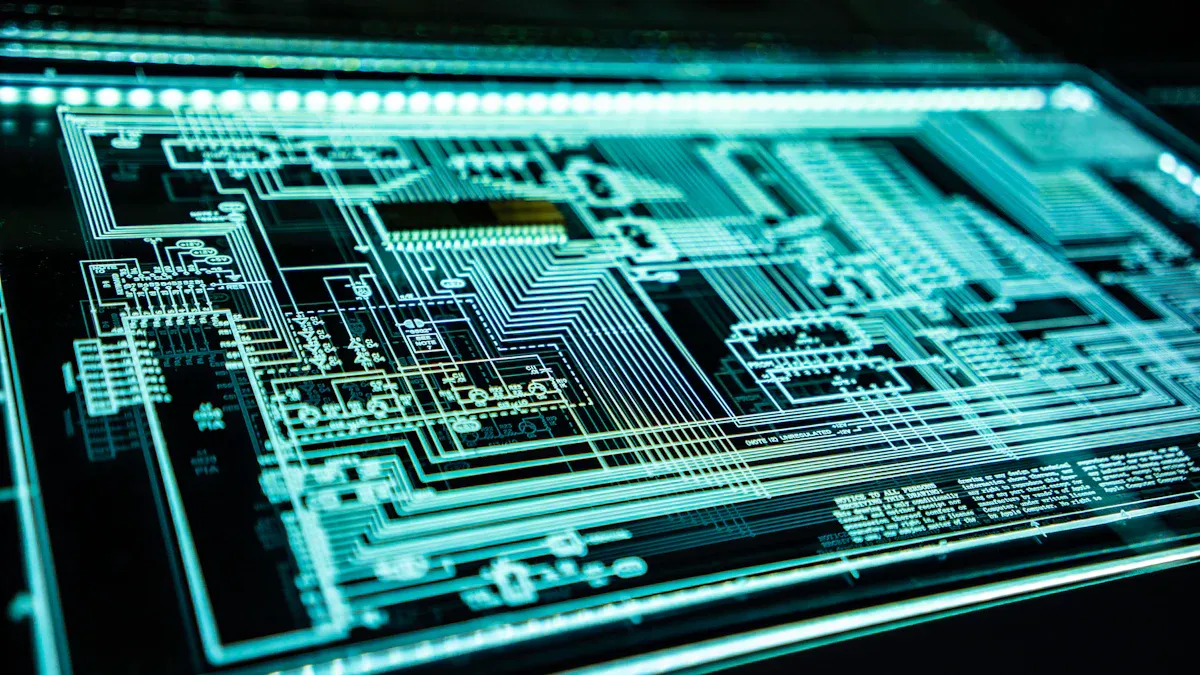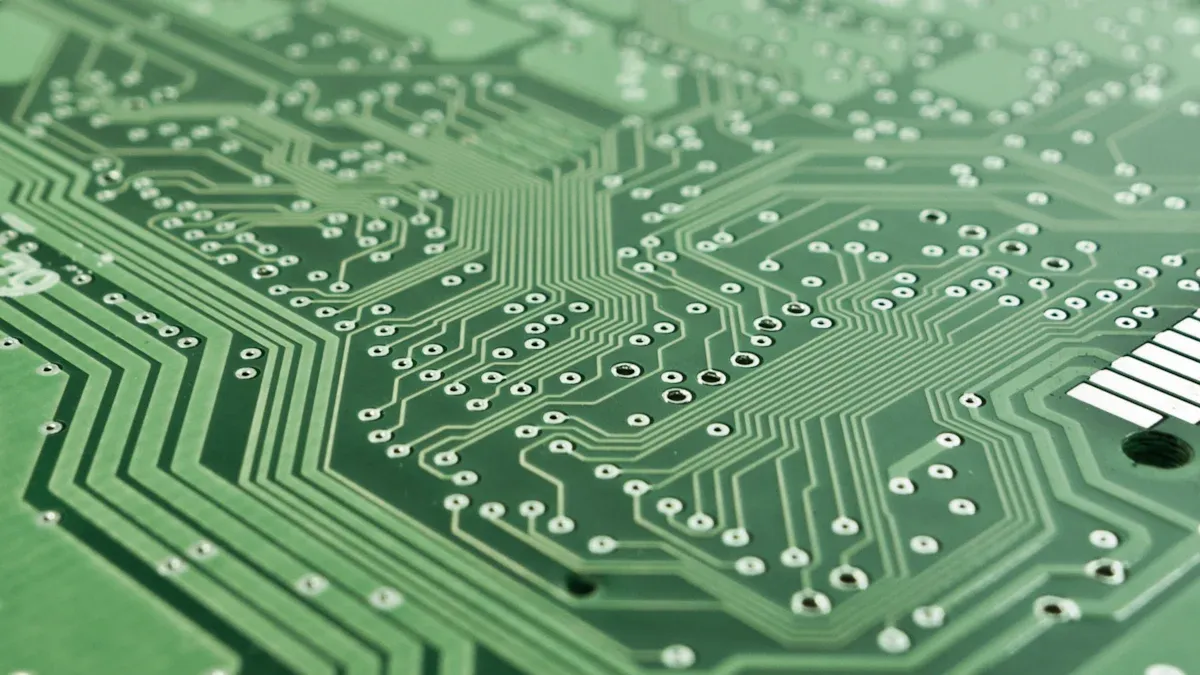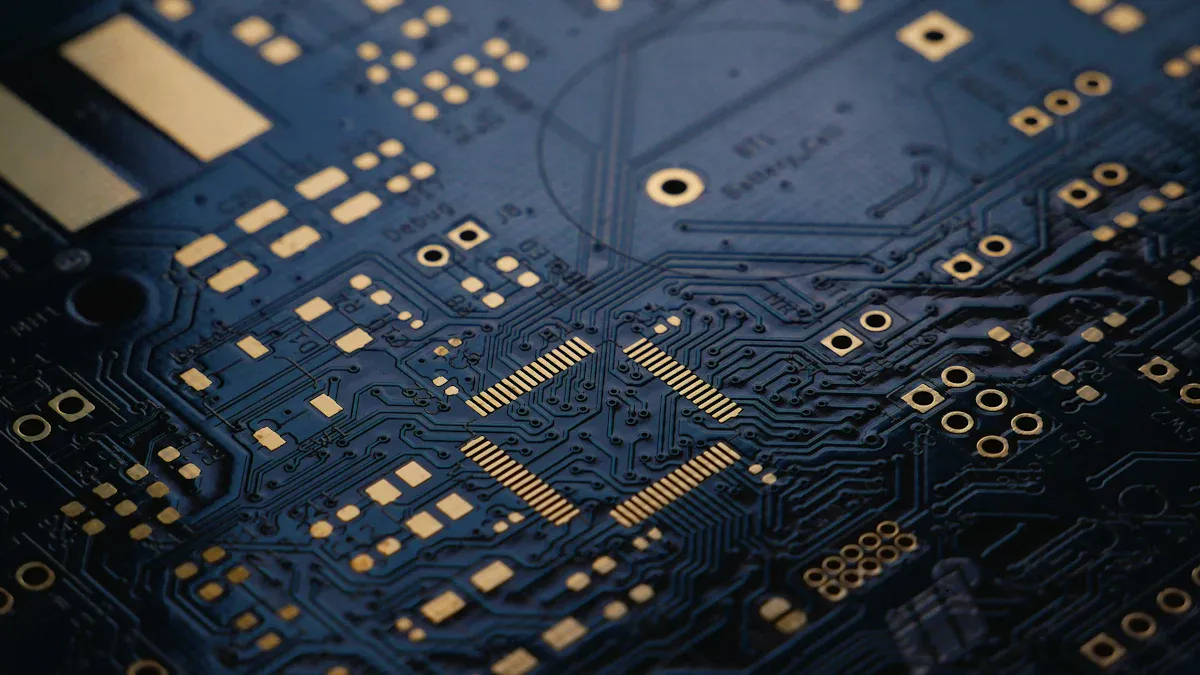Immersion Tin Finish for High-Reliability Industrial Control Applications

Immersion tin finish stands out as a reliable choice for high-reliability industrial control applications. Industry standards recognize this surface finish for its ability to protect the copper layer on a printed circuit board, offering excellent solderability and a flat, lead-free surface.
Immersion tin provides a re-workable finish, making it suitable for press fit technology and mechanical connections in demanding applications.
This finish maintains a flat surface, which supports consistent solder joints and improves printed circuit board assembly quality.
Technical benchmarks show that immersion tin finish consistently achieves the required plating thickness and strong solderability, even after thermal aging. This surface finish also demonstrates controlled ionic contamination and stable mask adhesion, which help prevent corrosion and ensure long-term reliability in industrial control applications. Proper selection of pcb surface finish directly impacts the performance and lifespan of every printed circuit board.
Key Takeaways
Immersion tin finish creates a flat, uniform surface that ensures strong solder joints and supports fine-pitch components, improving PCB assembly quality.
This finish protects copper from corrosion, offers thermal stability, and works well with lead-free solder, making it ideal for long-lasting industrial control applications.
Proper handling and storage of immersion tin PCBs prevent tin whiskering and maintain solderability, ensuring reliable performance throughout the product's life.
Immersion Tin Finish in Industrial Control PCBs

What Is Immersion Tin Finish?
Immersion tin finish is a chemical displacement plating process that deposits a thin, uniform layer of tin onto the copper surfaces of a printed circuit board. This process uses a tin salt solution, such as stannous sulfate or stannous fluoborate, to create a flat and consistent surface. The process begins with surface preparation, including cleaning and microetching to remove oxidation and activate the copper. Next, a protective flux is applied to prevent re-oxidation and support tin deposition. The printed circuit board then enters a heated immersion tin bath, where time and temperature are tightly controlled. After tin application, the board is rinsed in deionized water and dried to remove any moisture before further assembly.
Strict process controls ensure the surface finish remains uniform and meets the required thickness, typically between 0.8 and 1.2 micrometers. The immersion tin finish forms a copper-tin intermetallic compound layer, which provides a reliable solderable surface. This finish supports both eutectic and lead-free soldering, making it suitable for a wide range of applications, including industrial control, automotive, and telecommunications.
Aspect | Details |
|---|---|
Process | Immersion of PCB into tin salt solution (e.g., stannous sulfate or stannous fluoborate) |
Tin Layer Thickness | Typically 0.8 to 1.2 µm |
Surface Characteristics | Uniform, flat surface ideal for fine-pitch components |
Compatibility | Suitable for lead-free soldering processes; withstands higher soldering temperatures |
Intermetallic Compounds (IMCs) | Formation of Cu6Sn5 and Cu3Sn during soldering enhances mechanical and thermal properties |
Advantages | Provides oxidation barrier, good solderability, and reliability for industrial control PCBs |
Key Benefits for High-Reliability Applications
Industrial control applications demand consistent performance and long-term reliability from every printed circuit board. Immersion tin finish delivers several key benefits that make it a preferred surface finish for these environments:
Excellent solderability: The flat, uniform surface ensures strong solder joint integrity, even for fine-pitch components. This reduces the risk of cold solder joints and improves assembly quality.
Superior flatness: Immersion tin creates a smooth surface, which is essential for automated assembly and high-density interconnects. This flatness supports precise placement of components and reliable soldering.
Corrosion resistance: The tin layer acts as a barrier, protecting the copper from oxidation and environmental exposure. This extends the lifespan of the printed circuit board in harsh industrial settings.
Thermal stability: The granular structure of the tin layer, enhanced by organic additives, improves resistance to thermal cycling and maintains solderability after thermal aging.
Compatibility with lead-free solder: Immersion tin finish supports both traditional and lead-free soldering processes, making it versatile for modern assembly lines.
Consistent performance: Tight process controls and quality assurance measures ensure each pcb surface finish meets industry standards for thickness, adhesion, and solderability.
Note: Immersion tin finish is best suited for mass production runs, where consistent surface quality and excellent solderability are critical for high-reliability applications.
LT CIRCUIT’s Expertise in Immersion Tin PCB Solutions
LT CIRCUIT brings advanced manufacturing capabilities to the production of immersion tin finish printed circuit boards. The company uses state-of-the-art process controls to monitor solution concentration, temperature, pH, and immersion time. This ensures every pcb receives a uniform, high-quality surface finish that meets the demands of industrial control applications.
LT CIRCUIT’s expertise covers a wide range of applications, from industrial automation to telecommunications and medical devices. The company’s immersion tin process forms a stable copper-tin intermetallic compound layer, which enhances solder joint integrity and supports excellent solderability throughout the assembly process. Quality assurance protocols include thickness measurement, solderability testing, and adhesion checks, guaranteeing that each printed circuit board delivers reliable performance in the field.
With a focus on innovation and customer satisfaction, LT CIRCUIT provides tailored pcb surface finish solutions that address the unique requirements of high-reliability industrial control systems. Their commitment to quality and precision ensures that every immersion tin finish pcb meets the highest industry standards for durability, performance, and assembly efficiency.
Surface Finish Comparison and Best Practices

Immersion Tin vs. Other Surface Finishes
Selecting the right surface finish for a printed circuit board impacts both solderability and long-term reliability. Immersion tin stands out for its flat, uniform surface, which is ideal for fine-pitch components and high-density assembly. Compared to other circuit board surface finishes, immersion tin offers cost-effectiveness and excellent solder joint integrity. The table below highlights key differences among popular finishes:
Surface Finish Type | Surface Quality | Solderability | Shelf Life | Cost | Fine-Pitch Suitability | Notable Features |
|---|---|---|---|---|---|---|
Immersion Tin | Flat, smooth | Good | Moderate | Moderate | Yes | Excellent for fine-pitch, cost-effective |
ENIG | Excellent | Excellent | Long | High | Yes | Superior durability, reliable for critical applications |
HASL | Uneven | Excellent | Moderate | Low | No | Budget-friendly, less suitable for fine-pitch |
OSP | Flat | Good | Limited | Low | Yes | Eco-friendly, limited thermal cycles |
Immersion tin finish provides a balance between performance and cost, making it suitable for industrial control applications where both solder joint integrity and surface flatness are essential.
Reliability and Handling Considerations
Reliability in industrial environments depends on both the surface finish and proper handling. Immersion tin finish delivers strong solderability and maintains a flat surface, but it requires careful storage to prevent oxidation. Tin whiskering can occur if the surface is exposed to moisture or mechanical stress, potentially affecting solder joint integrity. To reduce whiskering, manufacturers recommend expedited packaging and strict contamination control. Shelf life for immersion tin typically ranges from 9 to 12 months, with best assembly results achieved within 30 days of application. Proper handling ensures the printed circuit board maintains reliable performance throughout its lifecycle.
Tip: Always store PCBs with immersion tin finish in a controlled environment to minimize tin whiskering and preserve solderability.
Best Practices for Industrial Control PCB Design
Engineers can optimize printed circuit board reliability by following best practices for surface finish selection and assembly. Immersion tin offers a very flat, thin surface, making it ideal for press-fit connectors and fine-pitch components. Designers may specify multiple finishes on a single board, using immersion tin for areas requiring low insertion friction and other finishes for exposed pads. LT CIRCUIT applies advanced process controls and quality assurance protocols, including thickness verification and solderability testing, to ensure every pcb surface finish meets industry standards. By combining careful design, proper storage, and rigorous testing, manufacturers achieve consistent solder joint integrity and minimize risks from tin whiskering, ensuring a reliable final surface finish for industrial control applications.
Immersion tin finish gives pcb assemblies a flat surface and strong solderability, making it ideal for industrial control applications. LT CIRCUIT delivers reliable pcb solutions with advanced process controls. Decision-makers should consider this finish for high-reliability applications that demand consistent performance and a dependable surface.
FAQ
What makes immersion tin finish a reliable choice for industrial control applications?
Immersion tin finish creates a flat, solderable surface. This finish supports excellent solderability and strong solder joint integrity, which improves printed circuit board performance in demanding applications.
How does immersion tin help prevent tin whiskering on a pcb?
Manufacturers use strict process controls and proper storage to reduce tin whiskering. This helps maintain a reliable final surface finish and ensures consistent solderability during assembly.
Can immersion tin finish support lead-free solder in pcb assembly?
Immersion tin finish works well with both traditional and lead-free solder. This compatibility makes it suitable for modern assembly lines and high-reliability industrial applications.
See Also
Expert Guide To Using Immersion Tin In PCB Design
Why Immersion Gold Outperforms Other PCB Finishes For Reliability
How Immersion Tin Affects Solder Mask Stability On PCBs
Key Considerations For Industrial PCB Production In Harsh Conditions
Understanding OSP Finish Benefits And Challenges In PCB Manufacturing
